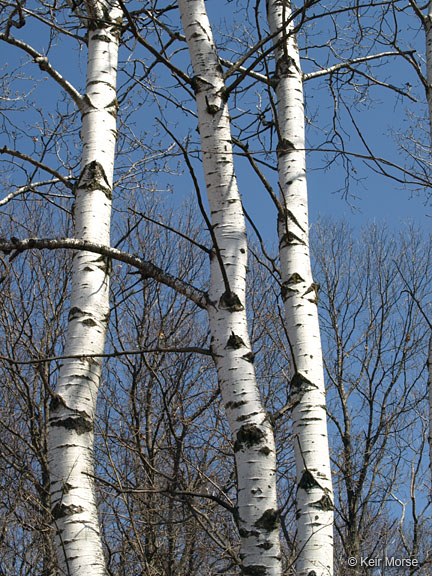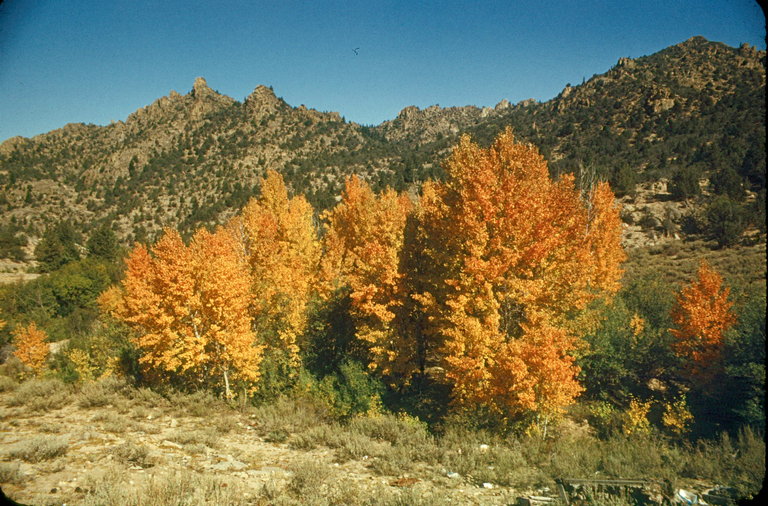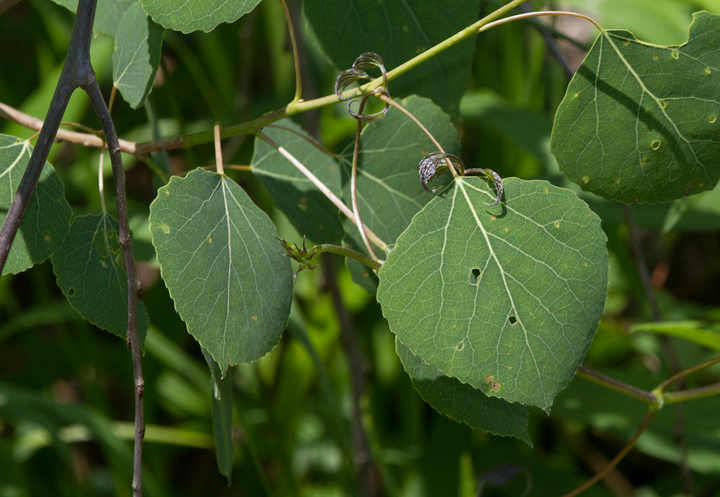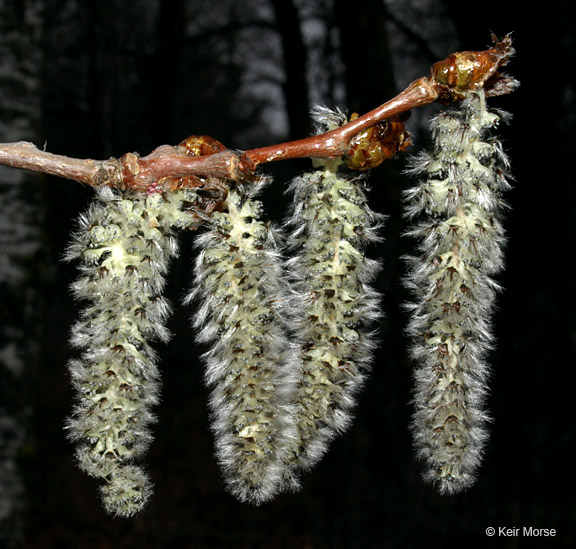Quaking Aspen
Populus tremuloides Michx.
Description
Populus tremuloides, commonly known as “quaking aspen” or “trembling aspen,” is a member of the willow family (Salicaceae) ¹. Individual trees can reach sizes of up to 100 feet² but are most commonly around 50-60 feet tall ³. Their bark is white with black “scars” which appear on the bark after the tree naturally prunes itself, dropping its lower branches as it grows taller ². They have simple, alternate, pinnately veined leaves with serrated edges ³. The tree gets its common names from the way its leaves shake in even the slightest breeze due to the long, flattened petioles connecting them to their stems ². They often do not flower, but when they do, they are dioecious, meaning the male and female flowers exist on trees from separate clones ³. The male flowers are brownish in color and around two inches in length while female catkins are much shorter ³ . The species often reproduces asexually, creating clones from the same root system ² . Individual trees may only live from decades to as much as 150 years, but the root system can live for thousands of years 4.

Stems of quaking aspen. K. Morse, CalPhotos 9

Fall color of a clone of quaking aspen. G. Monroe, CalPhotos 9

Leaves of quaking aspen. @B. Hubick*, Maryland Biodiversity Project 6

Male catkins of quaking aspen. K. Morse, CalPhotos 9
Distribution
Quaking aspens are the most widely distributed tree species in North America ¹. They are found as far north as Alaska, as far south as Mexico, and on both sides of the continent ¹. They can be found in both moist and dry environments and tend to prefer upland and mountainous locations ¹. They can be found at altitudes from sea level to 11,500 ¹. They are not common in Maryland but can be found in some areas of Garrett County 6 .

Natural range of quaking aspen ¹
Wildlife Importance
Quaking aspens are used by many species in the ecosystems they are found in. Aside from the cover and shelter they provide for many animals, additional species eat the foliage of quaking aspens including deer, elk, moose and other mammals ¹. They are also a host plant for several insect species including Tiger Swallowtails and Viceroy/Admiral butterflies 7. They are especially important for the Ruffed Grouse, a bird that can complete much of its life cycle in quaking aspen habitats within its range ¹.

Swallowtail butterfly caterpillar on quaking aspen. 8
Economic Importance
The wood of quaking aspens is used in several products including paper, particleboard, furniture, matchsticks, and tongue depressors1,4 . Aspen shavings are also an important product in the pet industry, often being used as a bedding material for many common pets like hamsters, turtles, and snakes 4 .
Threats
The primary threat to quaking aspens is overgrazing from animals like deer10. Because they reproduce clonally, they can grow more trees from their vast root system ¹. Due to the human induced decrease in the populations of many natural predators of deer, deer populations across North America are surging11. There is concern that because of this surge, deer overgrazing could kill more aspens faster than their root systems can replace the trees10. Pocket gophers can also threaten quaking aspens if they exist in large numbers by chewing their roots ². Porcupines can girdle the trees of an entire stand ¹. Fires suppression can lead to quaking aspen stands being overtopped and suppressed ¹.
Interesting Facts
- Quaking aspens can conduct photosynthesis using their bark in addition to their leaves, allowing them to grow year-round ².
- The largest organism in the world is thought to be a cluster of quaking aspens in Fishlake National Forest in Utah10 . The trees are genetically identical and come from the same root system that stretches 106 acres10. The organism is known as Pando which is Latin for “I spread”10 . Scientists do not know its exact age, but estimates range from around 10,000 to 80,000 years old10 .
- Because neighboring quaking aspens are often genetically identical, they change color at the same time in autumn , creating swaths of yellow forests that attract many tourists 4.
References
- USDA Forest Service Fire Effects Information System: Quaking Aspen
- National Park Service: Quaking aspen
- Iowa State University Extension and Outreach: Quaking aspen
- National Wildlife Federation– Quaking Aspen
- Jersey Yards– Populus tremuloides
- Maryland Biodiversity Project– Quaking Aspen (Populus tremuloides)
- California Native Plant Society– Quaking Aspen
- Raising Butterflies CalPhotos: Populus tremuloides
- CalPhotos: Populus tremuloides
- USDA Forest Service– Pando, Fishlake National Forest
- New York Department of Environmental Conservation
* Imaged used with permission of photographer.
Contributed by A. Nickey and T. Stern
